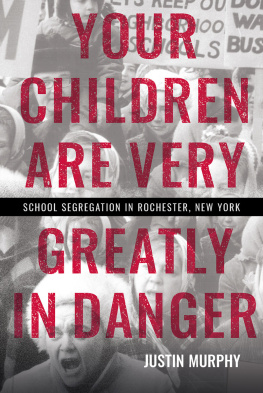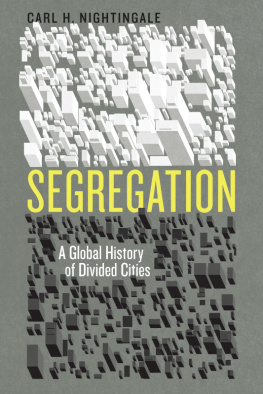Published by Louisiana State University Press
Copyright 2017 by LeeAnn G. Reynolds
All rights reserved
Manufactured in the United States of America
First printing
DESIGNER: Mandy McDonald Scallan
TYPEFACE: Whitman
PRINTER AND BINDER: McNaughton & Gunn, Inc.
Library of Congress Cataloging-in-Publication Data
Names: Reynolds, LeeAnn Garrison, author.
Title: Maintaining segregation : children and racial instruction in the South, 19201955 / LeeAnn G. Reynolds.
Other titles: Making the modern South.
Description: Baton Rouge : Louisiana State University Press, [2017] | Series: Making the modern South | Includes bibliographical references and index. | Based on the authors thesis (Ph. D.)Vanderbilt University, 2007.
Identifiers: LCCN 2016042878| ISBN 978-0-8071-6564-5 (cloth : alk. paper) | ISBN 978-0-8071-6565-2 (pdf) | ISBN 978-0-8071-6566-9 (epub) | ISBN 978-0-8071-6567-6 (mobi)
Subjects: LCSH: Southern StatesRace relations. | SegregationSouthern States. | Race awareness in childrenSouthern States. | Segregation in educationSouthern States. | Southern StatesRace relationsReligious aspects.
Classification: LCC E185.61 .R478 2017 | DDC 305.800975dc23
LC record available at https://lccn.loc.gov/2016042878
The paper in this book meets the guidelines for permanence and durability of the Committee on Production Guidelines for Book Longevity of the Council on Library Resources.

ACKNOWLEDGMENTS
The idea for this project began at Vanderbilt University in two courses with sociologist Larry Griffin. Memory studies were all the rage at the time, and for the first time I read autobiographies by southerners such as Lillian Smith, Anne Moody, and Carl Rowan. Although Larry and I have not always seen eye to eye on this project, he exposed me to sources and helped me frame questions that led me to a discovery: both black and white southerners remembered that silencethe unwillingness of parents to discuss segregation with their childrenhelped maintain the system. These autobiographies and others like them, along with John Cells analysis of segregation in the American South and South Africa, inspired me to explore segregation as an institution.
My interest in studying history began even earlier, when I took a U.S. history survey course with Bruce Wheeler at the University of Tennessee. Dr. Wheeler turned my amateur interest in southern history into a major, and he served as my advisor and mentor throughout my undergraduate career. I later studied African and South African history with Catherine Higgs. Dr. Higgss demand for excellence forced me to work harder, especially on my writing, and she convinced me that I might be able to pursue history as a career. In retrospect the coalescing of these areas of geographical focus likely laid the groundwork for my interest in segregation.
At Vanderbilt I encountered professors and graduate students who pushed me to develop as a historian but also to interrogate my worldview. I am indebted to all those who made my time at Vanderbilt so rewarding. My advisor, David Carlton, and I forged a warm and productive working relationship over the years, and I appreciate him letting me go my own way. Dennis C. Dickerson taught me African American and civil rights history and continues to serve as a source of encouragement. Others who assisted me, including Michael Kreyling, Devin Fergus, Chase Lesane-Brown, and Marjorie Spruill, provided invaluable advice, and Jim Epstein and Michael Bess offered friendship and reassurance throughout my graduate career. My graduate colleagues at Vanderbilt sustained me over the course of seven years, and their critiques made this project better. In particular I would like to thank Sue Marasco, Tim Boyd, Beth Sensing, Mark Vertuli, Steven P. Miller, Barry Robinson, Rachel Donaldson, Peter Kuryla, and Nicholas Beasley. Vanderbilts Department of History, American Studies Program, Center for Teaching, and Robert Penn Warren Center for the Humanities provided funding that helped me complete an earlier version of the project. The year I spent as a graduate fellow at the Warren Center was especially productive, in large part thanks to the feedback and support offered by the other fellows and director Mona Frederick.
After leaving Vanderbilt, I had the privilege of spending a year as a Franklin Postdoctoral Teaching Fellow at the University of Georgia, where the faculty and graduate students made me feel welcome. John Inscoe was kind enough to send me his extensive list of southern autobiographies early in my research process, and he took an interest in me and my work. Steve Berry also served as a source of friendship and wise counsel. During my years at Samford University, I have introduced many of my students to the same autobiographies that did so much to shape my thinking on southern history, and I have gained fresh perspective from seeing those narratives through their eyes. I am deeply grateful to my colleagues in the History Department, along with David Chapman, for giving me the time and space I needed to finish the book.
A number of institutions and individuals have provided crucial assistance that helped me complete this project. Grants from the Presbyterian Historical Society, the Southern Baptist Historical Library and Archives, and the General Commission on Archives and History of the United Methodist Church enabled me to spend extended time in their archives and find the sources I needed to expand my analysis of racial instruction in southern churches. Numerous archivists and librarians assisted me with finding documents, checking citations, and retrieving sources. My work would not have been possible without their skills and their willingness to help. Mark Smith took an early interest in this project and gave me valuable source suggestions. David Goldfield, my series editor at Louisiana State University Press, also expressed an interest in the project early on, and I am grateful for both his patience and his feedback as the book came to fruition. Rand Dotson and the rest of the editorial staff at the press have shepherded the project through the publication process, and the book is stronger for each person who took the time and care to work on it. My copyeditor, Elizabeth Gratch, saved me from numerous errors.
My personal debts are many. My faith has given me strength and resilience. My friends and family have worked with me to maintain close relationships despite the distance. They have cheered my successes and comforted me through setbacks and times of sadness, and I could not have persevered without them. My brother, Ross Reynolds, has encouraged me throughout my life, and he provided me with a place to stay on several research trips to North Carolina. My parents, Lois and Arlin Reynolds, have given me unfailing love and support. Knowing that they are always there to help me if I need them has given me the courage to take each new step in my life.








